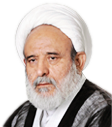Despite the well-developed status of the Imamite organization during the last period of al-Riďa's Imamate, he died, leaving a successor only seven years old, thus causing further splits amongst his followers. Al-Mas'udi mentions that because of the age of Muhammad al-Jawad, the ninth Imam, al-Riďa's followers were confused as to whether or not he possessed the requisite qualifications for the Imamate.
Therefore eighty leading personalities from various provinces, among them al-Rayyan b. al Salt, Safwan b. Yahya, Yunis b. `Abd al-Rahman, Muhammad b. Hakim, 'Ali b. al-Hasan al-Wasiti, and Ishaq b. Isma` il b. Nawbakht, gathered together at the house of `Abd al-Rahman b. al-Hajjaj in Baghdad to discuss the validity of al-Jawad's Imamate. They decided to test his knowledge during the pilgrimage. Two groups concluded that al-Jawad's age precluded his being qualified for the Imamate; the first group supported the Imamate of his uncle, Ahmad b. Musa al-Kazim, whereas the second group, including Ibrahim b. Salih alAnmati, joined the Waqifa and held that the seventh Imam .was al-Qa’im al-Mahdi[245].
But the rest were satisfied that al-Jawad's knowledge was exceptional and held that he was well qualified in spite of his age[246]. Hence they continued with the affairs of the organization, and sent propagandists from Kufa and Medina to various provinces. According to al-Najashi, many Kufan muhaddithun, such as Muhammad b. Muhammad b. al-Ash'ath, Ahmad b. Sahl, al-Husayn. b. `Ali al-Misri, and Isma` il b. Musa al-Kazim, moved to Egypt and carried on their activities there. One of these activities was to circulate the traditions of the Prophet concerning al-Qa’im al-Mahdi and the fact that he would be from the progeny of al-Husayn[247].
A narration mentioned by al-Kulayni suggests that they gained considerable adherents there, namely, that `Ali b. Asbat al-Kufi came from Egypt to Medina to see al-Jawad so as to describe him to the Imamites in Egypt[248]. Throughout the land of the caliphate the Imamite system of sending out agents (wukala') became more developed and managed to save their organization from certain disintegration. The Imam's agents spread in many provinces, like al-Ahwaz[249], Hamadan [250], Sistan, Bist' [251], Rayy [252], Basra[253], Wasit, Baghdad[254], and the traditional centres of the Imamites, Kufa and Qumm[255].
They allowed their partisans to work in the `Abbasid administration. Thus Muhammad b. Isma'il b. Bazi and Ahmad b. Hamza al-Qummi occupied high ranks in the vizierate[256], and Nuh b. Darraj was the qadi of Baghdad and then of Kufa. Because his relatives were the agents of al-Jawad, he hid his faith during his occupation of this post[257].
Other Imamites became governors of some `Abbasid provinces, such as al-Husayn b. `Abd Allah al-Nisaburi, the governor of Bist and Sistan, and al-Hakam b. `Alya al-Asadi, the governor of Bahrain. Both of these men paid the khums to al-Jawad while hiding their allegiance to him[258].
At this stage the underground activities of the agents only aimed at controlling and carrying on the religious and financial affairs of the Imamites, not at endangering al-Ma’mun's rule. However in the year 210/825 the people of Qumm, most of whom were Imamites, appealed to the caliph to reduce their land-tax (al-kharaj), just as he had reduced the kharaj of the inhabitants of Rayy, but he ignored their appeal. Therefore they refused to pay the kharaj and took control of the affairs of Qumm[259].
As a result al-Ma’mun dispatched three regiments of his army from Baghdad and Khurasan to quash their revolt. The leader of the Abbasid army, `Ali b. Hisham accomplished his task. He demolished the wall of Qumm and killed many people, amongst them Yahya b. `Umran, who, according to Ibn Shahr Ashub, was the agent of al-Jawad[260].
Moreover al-Ma’mun collected seven million dirhams from Qumm's inhabitants as a kharaj instead of the normal amount, which had been two million dirhams before the uprising. The reports of al-Tabari and Ibn al-Athir indicate that some of the leaders of this revolt were exiled to Egypt, among them Ja’far b. Dawud al-Qummi[261].
But these measures did not end the military activities in Qumm. According to al-Tabari, Ja’far b. Dawud escaped from Egypt and rebelled in Qumm in 214/829, but his revolt was subdued and he was arrested and banished again to Egypt[262].
Unfortunately the Imamite sources are silent about these military actions in Qumm and their relationship with the Imamites' organization. But al-Ma’mun linked these activities with al-Jawad. Thus he endeavoured to end them through the Imam. According to al-Azdi and al-Tabari, during his march to invade al-Rum, al-Mam'un summoned al-Jawad and welcomed him in Tikrit in Safar 215/830, where he married his daughter Umm al-Fadl to him. He asked him to celebrate his marriage in Baghdad, then to go back with his wife to Medina[263].
But this marriage neither gave al-Ma’mun the support of the Imamites nor stopped the revolts in Qumm. Ja`far b. Dawud managed to escape again from Egypt and rebelled in Qumm in 216/831, where he defeated the army sent by alMa’mun and killed its leader `Ali b. `Isa. He continued his resistance until the end of the year 217/832, when the `Abbasid troops ended his uprising and executed him[264].
But afterwards the underground activities of the `Alids increased on a wide scale. Therefore al-Mu`tasim, who succeeded al-Ma’mun to the caliphate in 218/833, was obliged to summon al-Jawad and Muhammad b. al-Qasim al-Talqan, so as to investigate their role in the underground activities. The latter, on hearing of al-Mu'tasim's decision, escaped from Kufa to Khurasan[265], whereas al-Jawad was arrested in Medina and taken along with his wife, Umm al-Fadl, to the caliph in Baghdad, where he was put under house-arrest. He died a few months later in Dhu al-Hijja 220/835. Some Imamite writers claim that his wife Umm al-Fadl poisoned him at the instigation of al-Mu'tasim, but al-Mufid thinks that he died naturally[266].
In the last few years of al-Jawad's Imamate the system and the tactics of the Imamite agents were highly developed. The Imam's followers in Khurasan allowed themselves to be recruited into the `Abbasid army and participated in subduing the rebellion of the Khurramiyya. According to al-Tusi, in 220/834 they seized a large amount of booty from the rebels, so al-Jawad ordered them to pay the khums either to him directly or to his agent[267]. Al-Jawad himself, on hearing of al-Mu'tasim's command to present himself inBaghdad, asked his representative Muhammad b. Al-Faraj to hand the khums to his son 'Ali al-Hddi as a .sign that he was to be his successor[268].
Notes:
[245]N. Firaq, 85-7; Q. Maqalat, 93-5; al-Najashi, 19.
[246] Ithbat, 213-5.
[247] al-Najashi, 21, 67-8, 141, 294.
[248]al-Kafi, I, 494.
[249]al-Najashi , 191.
[250]Ikhtiyar, 611-2; al-Najashi, 265.
[251]al-Kafi, V, 111.
[252] Bihar, L, 44-5.
[253]Ikhtiyar, 487; al-Najashi, 180.
[254] Ithbat, 213, 215.
[255] al-Kafi, I, 548; T. al-Ghayba, 227; Bihar, L, 37-8.
[256]al-Najashi, 254.
[257]al-Najashi, 80, 98; Mizan, IV, 276.
[258]al-Kafi, V, III; al-Tusi, al-Istibsar, II, 58.
[259]al-Azdi, 368.
[260] Ibn Shahr Ashub, Manaqib Ali Abi Talib, IV, 397; al-Azdi, 368.
[261]Tabari, III, 1092-3, 1102; al-Kamil, VI, 264, 293.
[262]Tabari, III, 1102.
[263]Tabari, III, 1103; al-Azdi, 399.
[264]Tabari, III, 1106, 1111; al-Kamil, VI, 286-7.
[265] Muhammad b. al-Qasim was the Imam of the revolutionary Zaydites during al-Jawad's period. When al-Mu`tasim endeavoured to arrest him, he escaped from Kufa and revolted in al-Talqan. But al-Mu`tasim captured him and imprisoned him in Samarra. Then he disappeared from jail mysteriously. Thus a considerable body of the Zaydites in the districts of Kufa, Tabaristan, Daylam and Khurasan held that he did not die but was alive and would rise in arms to fill the earth with justice after it had been filled with tyranny; Muruj, VI, 116-7.
[266] Ithbat, 220; Bihar, L, 15-17; al-Irshad, 297, 307.
[267] al-Tusi, al-Istibsar, II, 60-2.
[268] Ibn Shahr Ashub, Manaqib, IV, 389.
source : http://abna.ir













